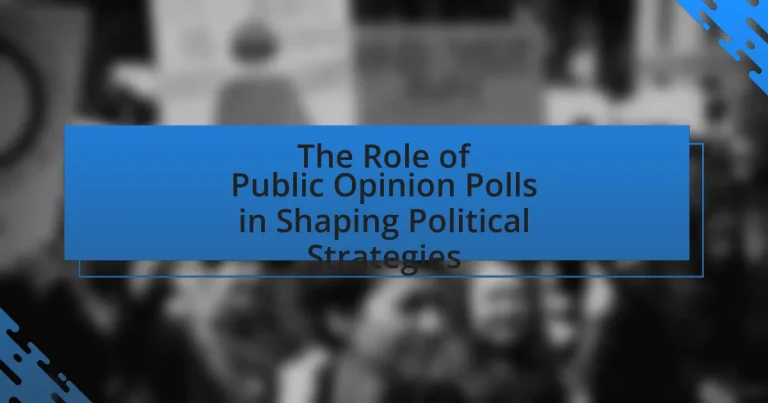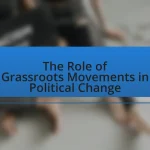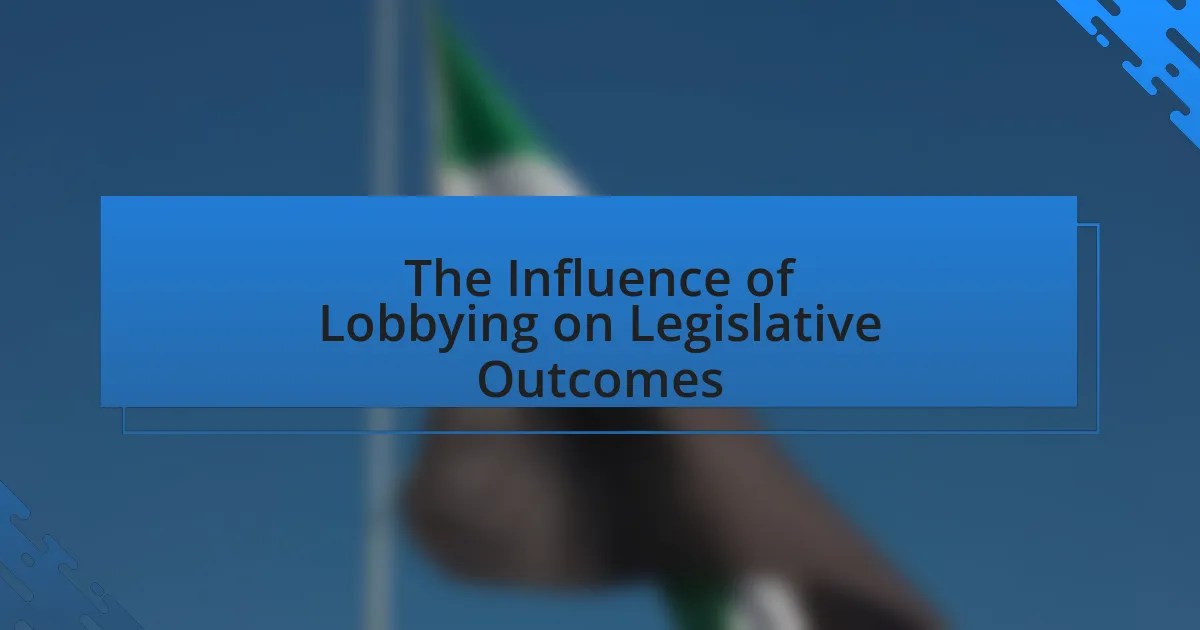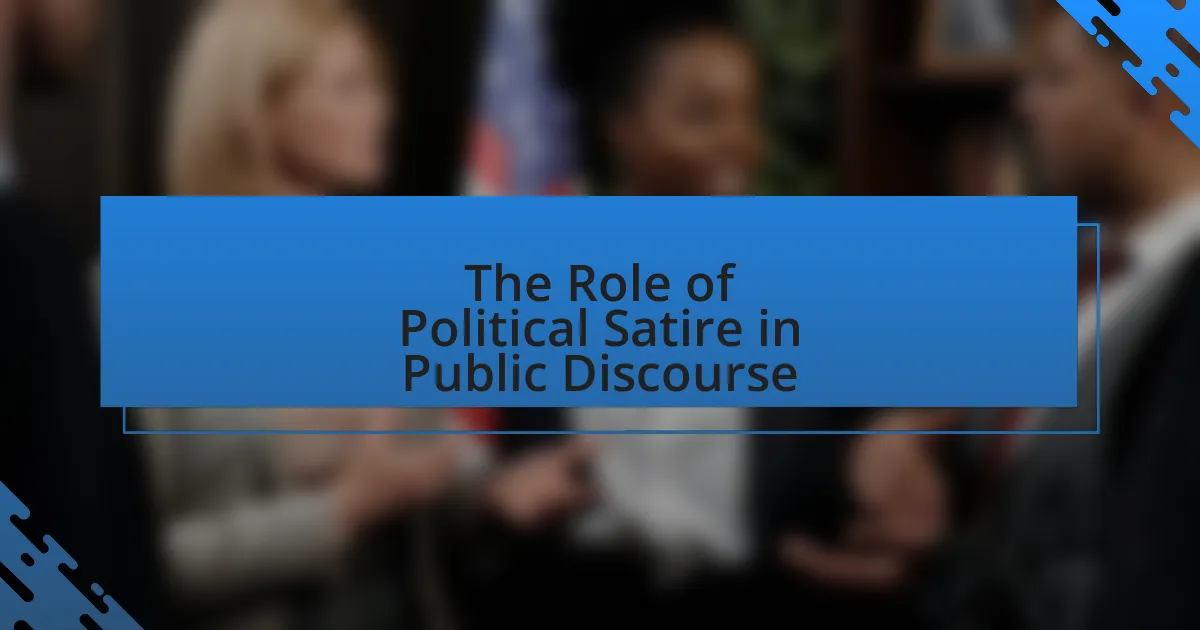Public opinion polls are essential tools that significantly influence political strategies by providing insights into voter preferences and sentiments. They enable candidates and parties to tailor their messages and policies, as evidenced during the 2020 U.S. presidential election, where healthcare reform emerged as a priority based on polling data. The article explores the methodologies used in conducting polls, their impact on political decision-making, and how they contribute to accountability in governance. Additionally, it examines the various types of polls, their limitations, and best practices for interpreting polling data, highlighting their critical role in shaping effective political strategies.
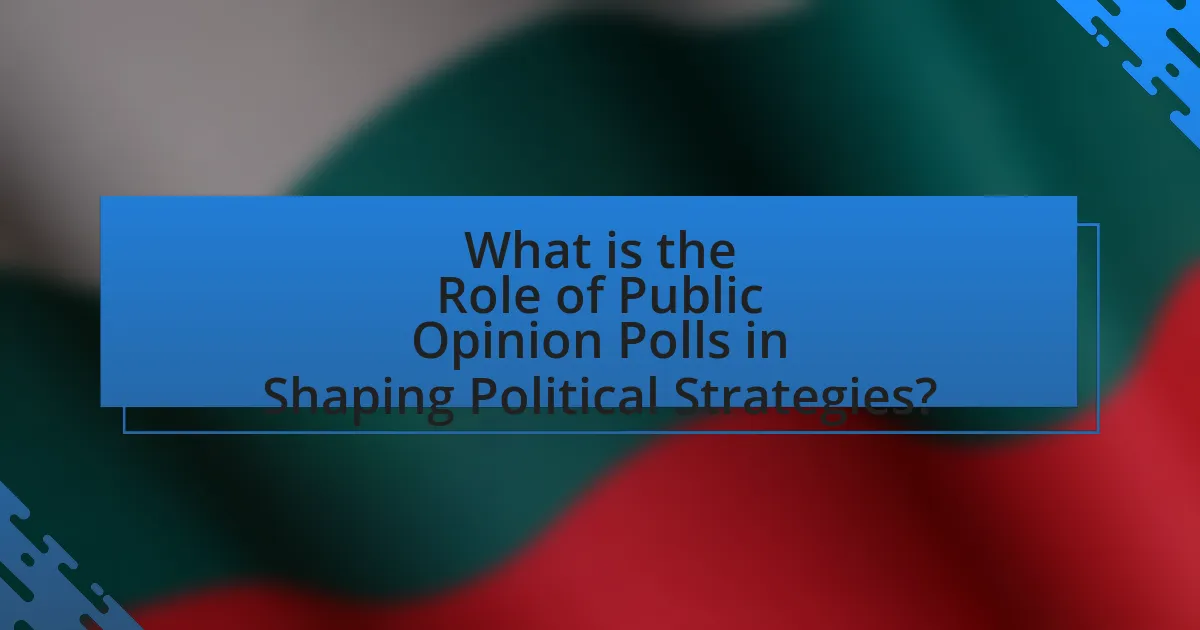
What is the Role of Public Opinion Polls in Shaping Political Strategies?
Public opinion polls play a crucial role in shaping political strategies by providing insights into voter preferences and sentiments. These polls enable political candidates and parties to gauge public opinion on various issues, allowing them to tailor their messages and policies accordingly. For instance, during the 2020 U.S. presidential election, polls indicated a strong preference for healthcare reform among voters, prompting candidates to prioritize this issue in their campaigns. Additionally, polls help identify key demographics and regions where support is strong or weak, guiding resource allocation and campaign efforts. The accuracy of these polls, often validated by their correlation with election outcomes, underscores their significance in strategic political planning.
How do public opinion polls influence political decision-making?
Public opinion polls significantly influence political decision-making by providing insights into voter preferences and sentiments. Politicians and political parties utilize these polls to gauge public support for policies, adjust campaign strategies, and prioritize issues that resonate with constituents. For instance, during the 2020 U.S. presidential election, polls indicated strong public support for healthcare reform, prompting candidates to emphasize this issue in their platforms. Additionally, research from the Pew Research Center shows that elected officials often align their legislative agendas with the prevailing public opinion reflected in polls, as this alignment can enhance their chances of re-election.
What methodologies are used in conducting public opinion polls?
Public opinion polls utilize several methodologies, including random sampling, stratified sampling, and online surveys. Random sampling ensures that every individual in the population has an equal chance of being selected, which enhances the representativeness of the results. Stratified sampling divides the population into subgroups and samples from each to ensure that specific demographics are accurately represented. Online surveys leverage digital platforms to gather responses quickly and cost-effectively, often reaching a broader audience. These methodologies are validated by their widespread use in reputable polling organizations, such as Gallup and Pew Research Center, which consistently demonstrate their effectiveness in accurately reflecting public sentiment.
How do the results of polls impact political campaigns?
Poll results significantly influence political campaigns by shaping candidate strategies, messaging, and resource allocation. Campaigns often adjust their platforms and focus areas based on polling data to align with voter preferences, as evidenced by the 2016 U.S. presidential election, where candidates tailored their messages in response to shifting public opinion. Additionally, polls can affect fundraising efforts; candidates who appear to be leading in polls may attract more donations, as seen in various congressional races where frontrunners received increased financial support. Overall, the strategic adjustments made in response to poll results can determine the effectiveness and direction of a political campaign.
Why are public opinion polls important in a democratic society?
Public opinion polls are important in a democratic society because they provide a measurable insight into the preferences and attitudes of the electorate. These polls help policymakers and political leaders understand public sentiment, enabling them to make informed decisions that reflect the will of the people. For instance, a Gallup poll conducted in 2020 indicated that 77% of Americans believed that public opinion should influence government policy, highlighting the significance of polls in aligning political actions with voter expectations. By capturing the collective voice of citizens, public opinion polls serve as a critical tool for accountability and responsiveness in democratic governance.
What role do polls play in reflecting voter sentiment?
Polls serve as a critical tool for gauging voter sentiment by providing quantitative data on public opinion regarding political candidates, issues, and policies. They capture the preferences and attitudes of a representative sample of the electorate, allowing political strategists to understand trends and shifts in voter behavior. For instance, a Gallup poll conducted in 2020 indicated that 56% of voters favored a specific policy proposal, demonstrating how polls can reflect prevailing public sentiment and influence campaign strategies. By analyzing this data, political campaigns can tailor their messaging and outreach efforts to align with voter priorities, ultimately shaping their strategies to enhance electoral success.
How do polls contribute to accountability in governance?
Polls contribute to accountability in governance by providing elected officials with measurable feedback on public opinion regarding their policies and performance. This feedback mechanism allows politicians to gauge the effectiveness of their actions and adjust their strategies accordingly to align with the electorate’s preferences. For instance, a study by the Pew Research Center found that 70% of voters believe that public opinion polls help hold politicians accountable by reflecting the views of constituents. By responding to poll results, officials can demonstrate responsiveness to the electorate, thereby enhancing democratic accountability.
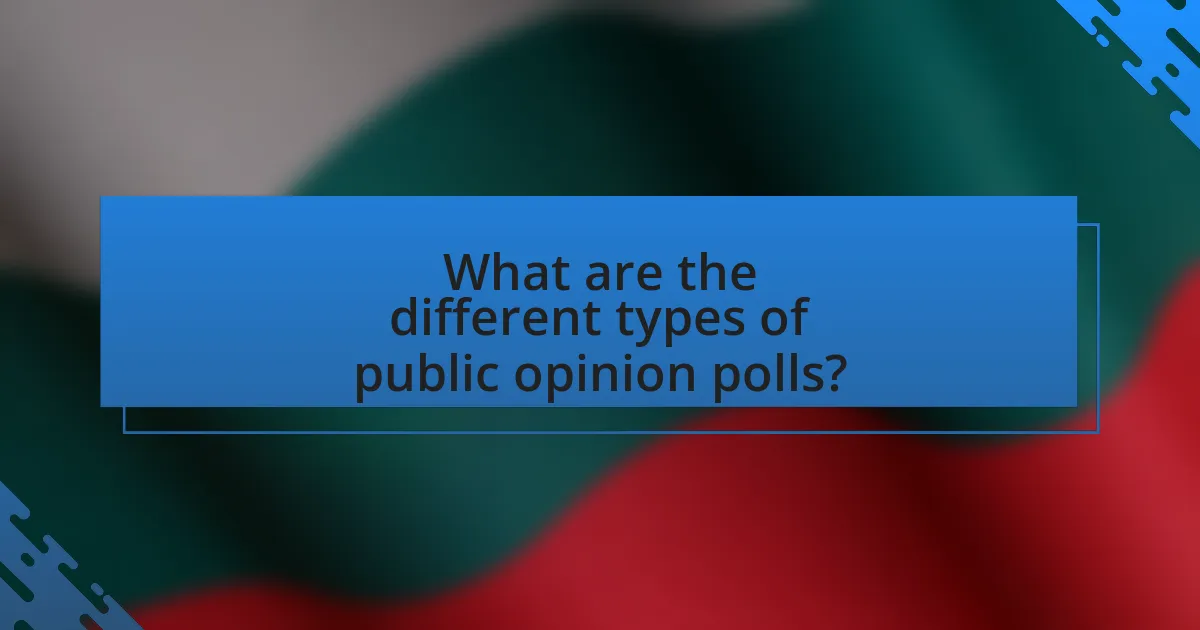
What are the different types of public opinion polls?
The different types of public opinion polls include tracking polls, benchmark polls, exit polls, and push polls. Tracking polls measure changes in public opinion over time by repeatedly surveying the same group of respondents, while benchmark polls establish a baseline of public opinion before a campaign begins. Exit polls are conducted immediately after voters leave polling places to gauge how different demographics voted, and push polls are designed to influence respondents’ opinions under the guise of gathering information. Each type serves distinct purposes in understanding and shaping political strategies.
How do tracking polls differ from exit polls?
Tracking polls differ from exit polls primarily in their timing and purpose. Tracking polls are conducted over a period of time to measure changes in public opinion, often leading up to an election, while exit polls are conducted immediately after voters leave polling places to gauge how they voted and why. Tracking polls provide insights into trends and shifts in voter sentiment, allowing campaigns to adjust strategies, whereas exit polls offer a snapshot of voter behavior and demographics at a specific moment, helping to analyze election outcomes.
What insights do tracking polls provide during elections?
Tracking polls provide real-time insights into voter preferences and trends during elections. These polls measure changes in public opinion over time, allowing campaigns to assess the effectiveness of their strategies and messaging. For instance, a tracking poll conducted by Gallup during the 2020 U.S. presidential election showed fluctuations in candidate support, which helped campaigns adjust their outreach efforts. By analyzing these trends, political strategists can identify key demographics, gauge voter sentiment, and respond to emerging issues, ultimately influencing campaign decisions and resource allocation.
How do exit polls help in predicting election outcomes?
Exit polls help in predicting election outcomes by providing immediate insights into voter behavior as individuals leave polling stations. These polls collect data on how different demographic groups voted, allowing analysts to gauge trends and make projections about the overall election results. For instance, during the 2008 U.S. presidential election, exit polls indicated that Barack Obama had strong support among young voters and minorities, which contributed to accurate forecasts of his victory. The accuracy of exit polls can be validated by comparing their results to the final vote counts, demonstrating their effectiveness in reflecting public sentiment at the time of voting.
What are the limitations of public opinion polls?
Public opinion polls have several limitations that can affect their accuracy and reliability. One major limitation is sampling bias, where the selected sample does not accurately represent the larger population, leading to skewed results. For instance, if a poll predominantly surveys individuals from a specific demographic, such as age or socioeconomic status, the findings may not reflect the views of the entire electorate. Additionally, polls can suffer from response bias, where respondents may provide socially desirable answers rather than their true opinions, further distorting the data. Furthermore, the timing of polls can impact results; opinions can shift rapidly due to current events, making polls outdated quickly. According to a study by the Pew Research Center, the accuracy of polls can vary significantly based on methodology, highlighting the importance of rigorous sampling techniques and question phrasing.
How can bias in polling affect political strategies?
Bias in polling can significantly distort political strategies by leading candidates to misinterpret voter preferences and adjust their campaigns based on inaccurate data. When polls are biased, they may over-represent certain demographics or viewpoints, causing political strategists to focus on issues that do not resonate with the broader electorate. For instance, if a poll disproportionately samples affluent voters, a candidate might prioritize policies appealing to that group, neglecting the concerns of lower-income voters who may be crucial for electoral success. Historical examples, such as the 2016 U.S. presidential election, illustrate how reliance on biased polling can result in strategic miscalculations, as many candidates underestimated the support for populist movements. Thus, bias in polling can lead to misguided campaign strategies that fail to align with the actual preferences of the electorate.
What factors can lead to inaccurate polling results?
Inaccurate polling results can arise from several factors, including sampling bias, question wording, and timing of the poll. Sampling bias occurs when the selected sample does not accurately represent the larger population, leading to skewed results; for instance, a poll that only surveys urban residents may not reflect the opinions of rural voters. Question wording can influence responses; leading or ambiguous questions may prompt respondents to answer in a way that does not accurately capture their true opinions. Additionally, the timing of a poll can affect results, as public sentiment may shift rapidly due to current events or news coverage, making results from a poll conducted at one time potentially misleading if public opinion changes shortly thereafter.
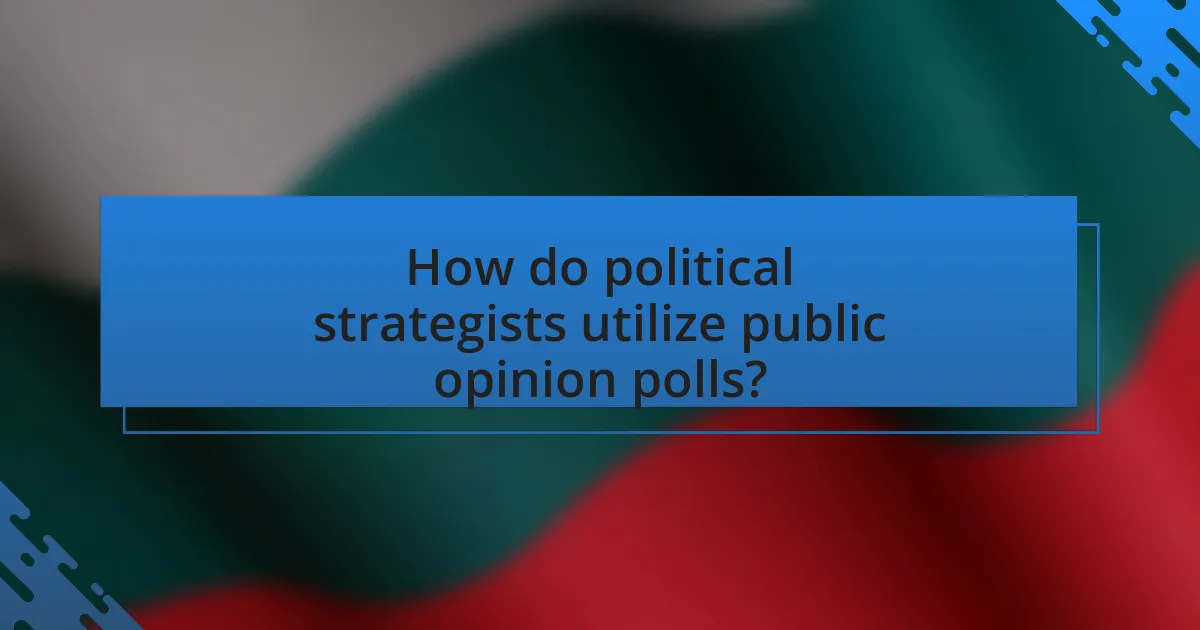
How do political strategists utilize public opinion polls?
Political strategists utilize public opinion polls to gauge voter sentiment and inform campaign strategies. By analyzing data from these polls, strategists can identify key issues that resonate with the electorate, adjust messaging, and allocate resources effectively. For instance, during the 2020 U.S. presidential election, polls indicated shifting attitudes on healthcare, prompting candidates to emphasize their healthcare plans in response to voter concerns. This strategic use of polling data helps campaigns tailor their approaches to maximize voter engagement and support.
What strategies do candidates employ based on poll results?
Candidates employ various strategies based on poll results to optimize their campaign efforts. These strategies include adjusting messaging to align with voter preferences, reallocating resources to focus on key demographics or regions identified in the polls, and modifying policy positions to resonate more with the electorate. For instance, if polls indicate strong support for a particular issue, candidates may emphasize that issue in their speeches and advertisements to attract undecided voters. Additionally, candidates may increase their engagement in areas where they are trailing, as indicated by polling data, to improve their standing. Historical examples include the 2008 U.S. presidential election, where Barack Obama shifted his campaign focus based on polling insights to strengthen his appeal among specific voter groups.
How do candidates adjust their messaging according to polling data?
Candidates adjust their messaging according to polling data by analyzing voter preferences and sentiments reflected in the polls. This analysis allows candidates to identify key issues that resonate with their target audience, enabling them to tailor their speeches, advertisements, and overall campaign strategies to align with voter concerns. For instance, if polling data indicates a significant concern about healthcare among voters, candidates may emphasize their healthcare policies and solutions in their messaging. Historical examples include the 2008 U.S. presidential election, where Barack Obama adjusted his messaging on economic recovery based on polling feedback, ultimately leading to a successful campaign.
What role do polls play in resource allocation during campaigns?
Polls play a critical role in resource allocation during campaigns by providing data that informs strategic decisions. Campaigns utilize polling data to identify voter preferences, gauge support for candidates, and determine which demographics to target. For instance, a study by the Pew Research Center found that campaigns that effectively analyze polling data can allocate resources more efficiently, focusing efforts on swing states or specific voter groups that show higher levels of support. This targeted approach allows campaigns to maximize their impact and optimize their spending, ultimately influencing the allocation of time, money, and personnel to areas with the greatest potential for electoral success.
How can public opinion polls shape policy decisions?
Public opinion polls can significantly shape policy decisions by providing lawmakers with insights into the preferences and priorities of their constituents. These polls serve as a barometer for public sentiment, allowing politicians to gauge support for specific issues or proposed legislation. For instance, a Gallup poll from 2021 indicated that 70% of Americans supported increased funding for renewable energy initiatives, prompting policymakers to prioritize such measures in their agendas. By reflecting the views of the electorate, public opinion polls can influence the legislative process, encouraging elected officials to align their policies with the demands of the public to maintain electoral support.
What examples exist of policies influenced by polling data?
Policies influenced by polling data include the Affordable Care Act in the United States and the legalization of same-sex marriage in various countries. The Affordable Care Act was shaped by public opinion that indicated strong support for healthcare reform, leading policymakers to prioritize it in their agendas. Similarly, polling data showed increasing acceptance of same-sex marriage, prompting lawmakers to advocate for its legalization, as seen in the U.S. Supreme Court’s decision in Obergefell v. Hodges in 2015, which reflected shifting public sentiment. These examples demonstrate how polling data can directly impact legislative priorities and outcomes.
How do elected officials respond to shifts in public opinion?
Elected officials respond to shifts in public opinion by adjusting their policies, communication strategies, and campaign messages to align with the prevailing sentiments of their constituents. For instance, when public opinion polls indicate a growing concern about climate change, officials may prioritize environmental legislation or adopt more aggressive climate policies to reflect this shift. Research shows that elected officials often rely on polling data to gauge public sentiment, which influences their decision-making processes and electoral strategies. A study by the Pew Research Center found that 70% of lawmakers consider public opinion polls as a significant factor in shaping their legislative priorities, demonstrating the direct impact of public sentiment on political actions.
What best practices should be followed when interpreting public opinion polls?
When interpreting public opinion polls, it is essential to consider the methodology used in the poll, including sample size, sampling method, and question wording. A robust sample size, typically at least 1,000 respondents, enhances the reliability of the results, while random sampling minimizes bias. Additionally, the phrasing of questions can significantly influence responses; neutral wording is crucial to avoid leading respondents toward a particular answer.
Furthermore, understanding the margin of error, which usually ranges from 2% to 4% for well-conducted polls, is vital for assessing the precision of the results. Polls should also be contextualized within the timeframe they were conducted, as public opinion can shift rapidly due to current events.
Finally, comparing multiple polls from different sources can provide a more comprehensive view of public sentiment, as individual polls may have unique biases or limitations. These best practices ensure a more accurate interpretation of public opinion data, which is critical for shaping effective political strategies.
